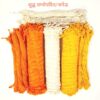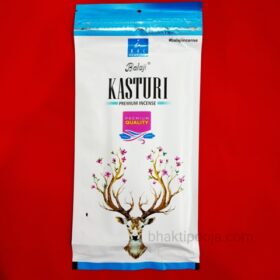Yagnopavit/Janeu (Sacred thread)
Price range: ₹15.00 through ₹55.00
Gayatri Parivar provides accurate, pure and sacred Yagnopavit/Janeu for all occasions and daily wearing. All the Yagnopavit/Janeu has Brahama Gaanth which is most important in Janeu. Various colours and sizes as per need are available.
Please see description for importance of Yagnopavit.
Janeu (Sacred thread)
Offering the janeu to Deities means binding the expanse of the brilliance of Deities in the rounds of the sacred thread and evoking them to function in duality. As the janeu is made of thread and is charged with the energy of a mantra, the frequencies of sound emitted by it activate the attributeless Principle of God from the Universe. This then functions for the embodied soul as per its bhāv towards God. The thread of janeu represents the silver link between God (non-duality) and the embodied soul (duality). Offering the janeu is an important process of interaction of duality and non-duality. Wearing this sacred thread after the ritualistic worship endows one with the sattva predominant Chai- Tanya of the Deity.
यज्ञोपवीतं परमं पवित्रं प्रजा पतेर्यत्सहजं पुरस्तात् । आयुष्यमग्रयं प्रतिमुञ्च शुभं। यज्ञोपवितम् बलमस्तुतेजः।।
yajnopavitam paramam pavitram prajapateryat-sahajam purastat ||
ayushyamagryam pratimuncha shubhram | yajnopavitam balamastu tejah ||
Above sloka describes the sanctity, spirituality and sacredness of yagnopavitam and its benefits. It says that yagnopavitam is “the best among those that purify; the one that has emerged along with Brahma (Prajapati) at the time of creation; that which bestows life (longevity) and prominence: the one that is sacred clean and unsoiled; and the one which confers on to the wearer both knowledge and power.”
Dwija
Dwija mean twice-born. There is no difference between one child and another at the time of birth. All are born out of the mother’s womb only. This is the first stage of life (Sudra). The second stage is getting upadesa of Gayathri at the time of Upanayanam when the boy becomes Dwija or twice-born. He is then purified. The third stage is Vipra when one has mastered the study of the Vedas. The fourth stage is Brahmana when he actually realizes the Brahman through the knowledge of the Self. One becomes a Brahmana not by birth but only when one realizes the Supreme Brahman. One becomes a Brahmana by action and not by birth.
Why should one wear Yagnopavit?
Wearing Yagnopavit would increase the longevity of a person who wears, gives physical and mental strength through the worship of Sun God (Savitha) using Gayathri Mantra initiated during his Upanayanam. By wearing Yagnopavit one gets purified both externally and internally. By wearing Yagnopavit one gets the eligibility to perform spiritual and sacred rituals (Sroutha/Smartha Karmas) as prescribed in Vedas for his Varna. Sacred rituals performed by wearing Yagnopavit give good results.
One should not attend to nature calls, eat food, and participate in sensual pleasures without Yagnopavit. It is a prerequisite for learning Veda. It is a passport to obtain a Vedic education. Yagnopavit is a mark of formal entry into Brahminhood. It gives power and authority to pursue one’s spiritual path.
Significance of wearing Yagnopavit
The Vedic link that a child loses when the umbilical cord is cut is re-established in the form of Yagnopavit. In other words, Yagnopavit serves as an umbilical cord that connects him not just to his immediate parents or imi three generations but to the entire tree of generations and the Rishi on whose root the whole tree flourished. The three strands remind the wearer that he has to pay off the three debts (Runas) he owes to the ancient seers, ancestors and to the God viz. Deva, Rushi, Pithru Runa.
Yagnopavit is not a mere symbol to identify a community. One who wears Yagnopavit need not necessarily be a Brahmin and the one who does not wear Yagnopavit may not be a non-Brahmin either. Yagnopavit has the sanctity of its own and one has to qualify himself for wearing it not by birth alone but also by practice. He alone is a Brahmin who does his Nithya Karma, follows the path of Sanatana Dharma and remains free from ego, avarice, anger and pride.
Sacred thread over the right ear lobe during urination or defaecation.
निवीती दक्षिणे कर्णे यज्ञोपवीतं कृत्वा मूत्रपुरीषे विसृजेत् । ऊर्ध्वं नाभर्मेध्यातरः पुरुषः परिकीर्तितः ।।
In short, it means that since the part of the body above the navel is considered pure and that below it impure, during urination and defaecation the sacred thread is worn as a chain (nivit) around the neck and is placed on the right ear. The scriptures often mention the importance of the right ear. Since it is the seat of various deities like Aditya, Vasu, Rudra, Vayu, Agni, Dharma, Veda, Apa, Som, Surya, Anil, etc. mere touch of the right ear bears the benefit of the ritual of sipping water from the palm (achaman). Thus by placing the sacred thread on the right ear which is pure, one is not bound by the restrictions of impurity.
The right ear assumes such scientific importance because the nerve endings and receptors situated here are closely related to the testes. During urination, there is a likelihood of passage of sperms in a small quantity. It is well documented by Ayurveda that seminal loss is prevented by encircling the right ear with a thread. The frequency in case of repeated nocturnal emissions can be reduced by keeping the right ear tied during sleep. An animal is subdued as soon as its ear is held. Of the seven causes of scrotal swelling, one is urinary. Encircling the ear with a thread prevents a scrotal swelling due to a urinary cause.
When to Change the Yagnopavit?
When once a person starts wearing Yagnopavit in normal circumstances it should not be removed and should be worn always (24 hours-365 days). It is like a woman wearing a Mangala Suthra forever. But in practice, it is not possible to wear the same Yagnopavit permanently. Due to wear and tear, it may get soiled or worn out or gets broken and needs to be changed. One should not wear a broken or worn out Yagnopavit. Apart from this it should be changed under the following circumstances.
Once in a year on the day of Upakarma, After performing Sraddha,
After completion of the stipulated period of asoucha (birth/death in the family). Whenever one visits the Cremation Ground or touches a Corpse, -Whenever one attends 10th-day ceremony and gives Dharmodaka.
– Whenever one happens to touch a woman during menstruation, – Whenever the threads of Yagnopavit are severed or it is soiled or worn out.
Whenever there is a need to change Yagnopavit it should not be removed recklessly. First, wear the new one and then remove the worn out as per the laid down procedure.
Procedure to wear the new Yagnopavit and remove the old one
ममोपात्त दुरितक्षयद्वारा श्री परमेष्वर पात्यर्धम आयुष्याभिवृदिअर्थम मम श्रीत स्मार्थ नित्य कर्मानुष्ठान योग्यता फल सिध्यर्थ नूतन यगोपवीत धारण करिष्ये ॥ (Dip your right hand middle finger in Panchapatra)
New Yagnopavit should be purified with turmeric paste or kumkum.
यज्ञोपवीत तस्य मंत्रसय परमे्टि परब्रहमार्ष परवहम देवता। देवा गायत्री घण्टः यजोपाता धारण विनियोगः ।
Wear Yagnopavit one set of threads after another reciting the following mantra.
While wearing Yagnopavit it should be held by both hands. the knot in the Yagnopavit being held above the head by the right hand facing upwards.
यशंपवीत धारण मंत्र (Yagnopavita dharana mantra)
यशीपटीत परम पविप्रजा पर्यत्महज पुरस्तात् । आयुष्यमय प्रतिमुम्प भायगोपडितम् बालमस्तुतेजः।।
yanapatam paramam pavitram prajapateryat-sahajam purastat syushyama sam pratimuncha shubhram yaincoavitam balamastu telah
(in case of Brahmachari only one Yagnopavit is prescribed. Grihastha should wear a second one after performing Aachamanam and reciting the Sankalpa:
मम गृहस्थाश्रम योग्यता सिध्यर्थ द्वितीय यज्ञोपवीत धारण करिष्ये।
mama gruhastasrama yogyata sidhyartam dwitiya yagnopavita dharanam karishye
The second Yagnopavit should be worn in the same manner as the first one by holding the thread above the head and reciting the adi UR Yagnopaveetha Dharana mantra).
Further, Grihastha should wear the third one in a similar manner after performing Aachamanam
with the following Sankalpa:
मम उत्तरीयार्धम तुतीय यज्ञोपवीत धारण करिष्ये ।
mama uttariyartama tritiya yagnopavita dharanam karishye |
and then recite once again the heart # (Yagnopavita Dharana mantra)
Remove the old Yagnopavit
Hold the knots of both the old and new Yagnopavit together in the right hand and recite the following mantra:
गायत्री वेद मातसी सूत्र रुपैण दिष्टसी पूर्व सूत्र गतम तेजा नूतने स्थापयाम्यहम।
gayatri veda matasi sutra rupena dishtasi purva sutra gatam teja nutana stapayamyaham
Do the japa of Gayatri mantra 10 times holding together the knots of both the old and new yagnopaveetham.
Yagyopavit Visarjan Mantra :-
उपवीत भिन्न (किन्न) तन्तु आगे कामन दायत डिसूजागि जाने सम्ह पर्यादापीयु रस्तुमे ।
upavitam binn tantum jeernam kasmala dushitam Srujami jale brahma vaja deerghayu rastume
Old Yagyopavit should be dropped into water or on a Tree and should not be thrown into the garbage.
Para Brahma Upanishad describes the inner meaning of the sacred thread (up-nayana / Janoi)
- Then to this realized person reality (i.e. true wisdom) constitutes the inner tuft and sacred thread. To the Brahmana desirous of liberation is (allowed) the state of the inward tuft and sacred thread. The wearing of externally visible tuft and sacred thread (is necessary) for the householders engaged in rituals. The characteristic of the inward sacred thread is not clearly visible like an external thread; it is the union with reality inwardly.
Interestingly, upanayana (up-nayana) means extra eye. Nayana means eye. It may be referred to as third eye (of knowledge), yogic may call it 3rd eye as ajna chakra. 3 threads represent the famous trinity like satva-rajas-tamas, waking-dream-deep sleep, etc. Brahmin wearing 3 sacred threads means to rise above trinity of bondage. While the external thread (which is visible), makes a brahmin qualify to recite Vedas and Upanishads, internal thread is more concerned with the union of reality i.e. knowledge of true Self – Atman / Brahman.
| Weight | 100 g |
|---|---|
| Colour | White, Yellow, Orange, Cream |
| Quantity | 5, 10, 20, 40 |
| Type | Thin, Medium, Thik |

























Reviews
There are no reviews yet.